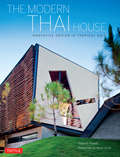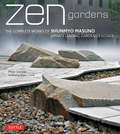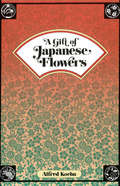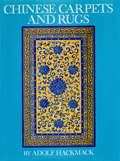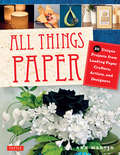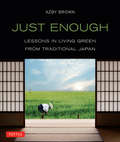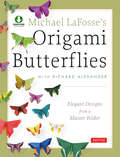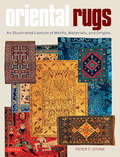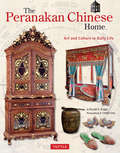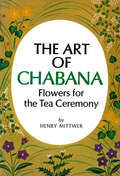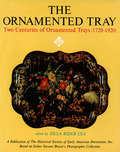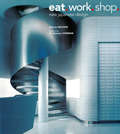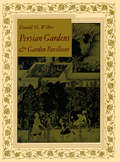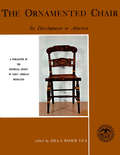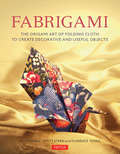- Table View
- List View
The Modern Thai House
by Robert Powell Albert Lim Ks[A tremendous body of sophisticated and sensitively designed architectural work has been produced in Thailand in the first decade of the 21st century. The 25 houses in The Modern Thai House illustrate the radical new ideas coming from a dynamic younger generation of architects who are producing work comparable with and sometimes even surpassing the very best architecture in the world.] Most of these architects were trained in the U.S. or U.K. and reflect not only American and European sensibilities but also affinities with their contemporaries in Asia-including Japan, China, Singapore, and Bali-all hotbeds for innovation in modern design. The houses in this book are readily accessible from Bangkok, Phuket, and Chiangmai. They reflect a wide variety of concerns and solutions, such as: sustainability; responses to climate; strategies for cooling with minimal electricity; openness versus security in a large metropolis such as Bangkok; cultural sensitivity and responsiveness, as evidenced in a "three-generation house," built for a society in which the extended family is still prevalent; and cultural memory, as in the use of elements such as pilings, verandahs, and steeply pitched roofs with large overhangs that echo traditional Thai designs.[Nurtured by an increasingly knowledgeable and wealthy clientele, modern architecture in Thailand is emerging with a variety of innovative architectural expressions.]
Zen Gardens
by Mira Locher Uchida ShigeruShunmyo Masuno, Japan's leading garden designer, is at once Japan's most highly acclaimed landscape architect and an 18th-generation Zen Buddhist priest, presiding over daily ceremonies at the Kenkoji Temple in Yokohama. He is celebrated for his unique ability to blend strikingly contemporary elements with the traditional design vernacular. He has worked in ultramodern urban hotels and in some of Japan's most famous classic gardens. In each project, his work as a designer is inseparable from his Buddhist practice. Each becomes a Zen garden, "a special spiritual place where the mind dwells."This beautiful book, illustrated with more than 400 drawings and color photographs, is the first complete retrospective of Masuno's work to be published in English. It presents 37 major gardens around the world in a wide variety of types and settings: traditional and contemporary, urban and rural, public spaces and private residences, and including temple, office, hotel and campus venues. Masuno achieved fame for his work in Japan, but he is becoming increasingly known internationally, and in 2011 completed his first commission in the United States which is shown here.The book, divided into three chapters, covers: "Traditional Zen Gardens," "Contemporary Zen Gardens," and "Zen Gardens outside Japan." Illustrated with photographs and architectural plans or sketches, each garden is described and analyzed by author Mira Locher, herself an architect and a scholar well versed in Japanese culture.Celebrating the accomplishments of a major, world-class designer, Zen Gardens also serves as something of a master class in Japanese garden design and appreciation: how to perceive a Japanese garden, how to understand one, even how to make one yourself. Like one of Masuno's gardens, the book can be a place for contemplation and mindful repose.
Zen Gardens
by Mira Locher Uchida ShigeruShunmyo Masuno, Japan's leading garden designer, is at once Japan's most highly acclaimed landscape architect and an 18th-generation Zen Buddhist priest, presiding over daily ceremonies at the Kenkoji Temple in Yokohama. He is celebrated for his unique ability to blend strikingly contemporary elements with the traditional design vernacular. He has worked in ultramodern urban hotels and in some of Japan's most famous classic gardens. In each project, his work as a designer is inseparable from his Buddhist practice. Each becomes a Zen garden, "a special spiritual place where the mind dwells."This beautiful book, illustrated with more than 400 drawings and color photographs, is the first complete retrospective of Masuno's work to be published in English. It presents 37 major gardens around the world in a wide variety of types and settings: traditional and contemporary, urban and rural, public spaces and private residences, and including temple, office, hotel and campus venues. Masuno achieved fame for his work in Japan, but he is becoming increasingly known internationally, and in 2011 completed his first commission in the United States which is shown here.The book, divided into three chapters, covers: "Traditional Zen Gardens," "Contemporary Zen Gardens," and "Zen Gardens outside Japan." Illustrated with photographs and architectural plans or sketches, each garden is described and analyzed by author Mira Locher, herself an architect and a scholar well versed in Japanese culture.Celebrating the accomplishments of a major, world-class designer, Zen Gardens also serves as something of a master class in Japanese garden design and appreciation: how to perceive a Japanese garden, how to understand one, even how to make one yourself. Like one of Masuno's gardens, the book can be a place for contemplation and mindful repose.
A Gift of Japanese Flowers
by Alfred KoehnEnjoyed by young and old, rich and poor, hanami, or flower-viewing, is an integral part of the Japanese people's appreciation of beauty in nature, and plays an important role in their social life as well.
Chinese Carpets and Rugs
by Adolf HackmackFirst published in the famous rug-making city of Tientsin more than fifty years ago in a limited edition, the book has unjustly been out of print for far too long. It has been the object of eager and futile search by many collectors, and its reappearance here in a faithful photographic reprint is certain to be welcomed by all discerning students of carpet weaving in one of its most famous and delightful forms. The book presents valuable essays on the development of carpet weaving, the colors of Chinese carpets, and the weaving process. The enduring worth of this book is proved by its continuing high reputation among collectors.
Chinese Carpets and Rugs
by Adolf HackmackFirst published in the famous rug-making city of Tientsin more than fifty years ago in a limited edition, the book has unjustly been out of print for far too long. It has been the object of eager and futile search by many collectors, and its reappearance here in a faithful photographic reprint is certain to be welcomed by all discerning students of carpet weaving in one of its most famous and delightful forms. The book presents valuable essays on the development of carpet weaving, the colors of Chinese carpets, and the weaving process. The enduring worth of this book is proved by its continuing high reputation among collectors.
Chinese Carpets and Rugs
by Adolf HackmackFirst published in the famous rug-making city of Tientsin more than fifty years ago in a limited edition, the book has unjustly been out of print for far too long. It has been the object of eager and futile search by many collectors, and its reappearance here in a faithful photographic reprint is certain to be welcomed by all discerning students of carpet weaving in one of its most famous and delightful forms. The book presents valuable essays on the development of carpet weaving, the colors of Chinese carpets, and the weaving process. The enduring worth of this book is proved by its continuing high reputation among collectors.
Chinese Carpets and Rugs
by Adolf HackmackFirst published in the famous rug-making city of Tientsin more than fifty years ago in a limited edition, the book has unjustly been out of print for far too long. It has been the object of eager and futile search by many collectors, and its reappearance here in a faithful photographic reprint is certain to be welcomed by all discerning students of carpet weaving in one of its most famous and delightful forms. The book presents valuable essays on the development of carpet weaving, the colors of Chinese carpets, and the weaving process. The enduring worth of this book is proved by its continuing high reputation among collectors.
All Things Paper
by Ann MartinAnn Martin has searched the world over for unique and beautiful paper crafts to feature on her popular website--AllThingsPaper.net. In this book, she gathers completely new projects and shows how each is created, step-by-step.All of the paper products in this book are designed by respected paper craft artists, such as Benjamin John Coleman, Patricia Zapata, and Richela Fabian Morgan, who have been making amazing things with paper for many years. Each of the projects, from simple to more complex, has easy-to-follow instructions and detailed photos enabling you to create your own! These colorful and impressive pieces include art objects to display at home as well as items which have practical uses. All of the pieces make a wonderful keepsake or a gift that expresses the beauty, elegance, and versatility of paper.Projects include:Candle LuminariesCitrus Slice CoastersMysterious Stationery BoxEveryday Tote BagSilver Orb PendantFine Paper Yarn NecklaceWedding Cake CardPerfect Journey Journal
Just Enough
by Azby BrownThe world has changed immeasurably over the last thirty years, with more, bigger, better being the common mantra. But in the midst of this constantly evolving world, there is a growing community of people who are looking at our history, searching for answers to issues that are faced everywhere, such as energy, water, materials, food and population crisis.In Just Enough, author Azby Brown turned to the history of Japan, where he finds a number of lessons on living in a sustainable society that translate beyond place and time. This book of stories depicts vanished ways of life from the point of view of a contemporary observer, and presents a compelling argument around how to forge a society that is conservation-minded, waste-free, well-housed, well-fed and economically robust.Included at the end of each section are lessons in which Brown elaborates on what Edo Period life has to offer us in the global battle to reverse environmental degradation. Covering topics on everything from transportation, interconnected systems, and waste reduction to the need for spiritual centers in the home, there is something here for everyone looking to make changes in their life.Just Enough is much-needed beacon in our evolving world, giving us hope in our efforts to achieve sustainability now.
Michael LaFosse's Origami Butterflies
by Richard L. Alexander Michael G. LafosseWhimsical, exquisite and fragile, butterflies and moths have enchanted and inspired people for centuries. Origami artist Michael G. LaFosse is no exception. His original butterfly paper-folding techniques are a dramatic new development in origami-which some have hailed as the most important advance in origami since the first paper cranes appeared centuries ago. Hundreds of LaFosse butterflies have been featured in exhibitions around the world and his iconic designs are now eagerly sought and widely imitated by folding enthusiasts everywhere.Michael LaFosse's Origami Butterflies presents 26 original projects from LaFosse's extensive butterfly and moth repertoire, including all his personal favorites. This collection has many rarely-seen designs, and several of the models illustrate new technical and design achievements made possible by the ingenious "LaFosse Origami Butterfly Folding System."These elegant forms-each created from a single square sheet of paper without cutting or glue-showcase the versatility of the folding system. All are deceptively simple, yet provide a solid foundation for creative flights of fancy in the hands of an experienced folder. Clear step-by-step instructions show you how to make literally hundreds of different variations by making small adjustments to a few key folds! Whether dry-folded from recycled candy wrappers or wet-folded from expensive handmade papers, these designs exemplify the best aspects of the paper folder's art today.This exciting new book with accompanying DVD represents the culmination of a lifetime of designing and perfecting the art of origami butterflies. It contains everything you need to create your own unique collection!Butterflies include:A Butterfly for Vanessa GouldThe Butterfly for Robert LangA Butterfly for Eric JoiselA Swallowtail for Guy KawasakiThe Boston ButterflyThe Mudarri Luna Moth
Oriental Rugs
by Peter F. StoneThis monumental reference work--long awaited by collectors and scholars--fills an important gap in the available literature on oriental rugs. Lavishly illustrated with over 1000 photographs and drawings, it offers clear and precise definitions for the rug and textile terms in use across a broad swath of the globe--from Morocco to Turkey, Persia, the Caucasus region, Central Asia, Afghanistan, Pakistan, India and China. Covering priceless museum-quality rug traditions as well as modern centers of production, Oriental Rugs draws on classical scholarship as well as current terminology in use among producers and traders in these areas today. It focuses primarily on the rich hand-knotting and hand-weaving traditions of the Near East and Central Asia, but also includes some examples of Scandinavian and Native American weavings.Rugs are receiving ever-increasing attention and recognition in the field of art history. Tribal weavings especially have become a focus for new research, and Oriental Rugs provides a new understanding of many distinctive traditions that were previously understudied, such as the weavings of southwest Persia, Baluchistan and Kurdistan. A concise reference, this volume is a must-have for serious collectors and scholars.
The Peranakan Chinese Home
by A. Chester Ong Ronald G. KnappDiscover the rarified Peranakan (native-born Chinese of Southeast Asia) aesthetics that are today highly sought-after for their beauty: distinctive furniture and ceramics, textiles and jewelry, and many other art objects. Peranakan Chinese Home displays these extraordinary objects, visible markers of a highly developed culture.The broad range of beautiful objects which the Peranakan Chinese created and enjoyed in their daily lives is astounding. Each chapter in Peranakan Chinese Home focuses on a different area and presents objects used or found in those spaces. Each piece is described in the context of their utility as household objects, as part of periodic celebrations to mark the Chinese New Year and other holidays, or in important life passage rituals relating to ancestor worship, birth, marriage, mourning and burial. The meaning of the rich symbolic and ornamental motifs found on the objects is discussed in detail and key differences are highlighted between Peranakan objects and similar ones found in China.A fascinating mix of Chinese, European and Southeast Asian influences, the distinctly Peranakan identity of a people and their culture is beautifully portrayed through objects and archival photographs in this lovely and exotic book.
The Peranakan Chinese Home
by A. Chester Ong Ronald G. KnappDiscover the rarified Peranakan (native-born Chinese of Southeast Asia) aesthetics that are today highly sought-after for their beauty: distinctive furniture and ceramics, textiles and jewelry, and many other art objects. Peranakan Chinese Home displays these extraordinary objects, visible markers of a highly developed culture.The broad range of beautiful objects which the Peranakan Chinese created and enjoyed in their daily lives is astounding. Each chapter in Peranakan Chinese Home focuses on a different area and presents objects used or found in those spaces. Each piece is described in the context of their utility as household objects, as part of periodic celebrations to mark the Chinese New Year and other holidays, or in important life passage rituals relating to ancestor worship, birth, marriage, mourning and burial. The meaning of the rich symbolic and ornamental motifs found on the objects is discussed in detail and key differences are highlighted between Peranakan objects and similar ones found in China.A fascinating mix of Chinese, European and Southeast Asian influences, the distinctly Peranakan identity of a people and their culture is beautifully portrayed through objects and archival photographs in this lovely and exotic book.
The Peranakan Chinese Home
by A. Chester Ong Ronald G. KnappDiscover the rarified Peranakan (native-born Chinese of Southeast Asia) aesthetics that are today highly sought-after for their beauty: distinctive furniture and ceramics, textiles and jewelry, and many other art objects. Peranakan Chinese Home displays these extraordinary objects, visible markers of a highly developed culture.The broad range of beautiful objects which the Peranakan Chinese created and enjoyed in their daily lives is astounding. Each chapter in Peranakan Chinese Home focuses on a different area and presents objects used or found in those spaces. Each piece is described in the context of their utility as household objects, as part of periodic celebrations to mark the Chinese New Year and other holidays, or in important life passage rituals relating to ancestor worship, birth, marriage, mourning and burial. The meaning of the rich symbolic and ornamental motifs found on the objects is discussed in detail and key differences are highlighted between Peranakan objects and similar ones found in China.A fascinating mix of Chinese, European and Southeast Asian influences, the distinctly Peranakan identity of a people and their culture is beautifully portrayed through objects and archival photographs in this lovely and exotic book.
Quiet Beauty
by Kendall H. Brown David M. CobbQuiet Beauty: Japanese Gardens of North America is an extraordinary look at the most beautiful-and serene-gardens in the United States and Canada. Most Japanese garden books look to the gardens of Japan. Quiet Beauty explores the treasure trove of Japanese gardens located in North America. Featuring an intimate look at twenty-six gardens, with numerous stunning color photographs of each, that detail their style, history, and special functions, this book explores the ingenuity and range of Japanese landscaping.Gardens include: Japanese Tea Garden in Golden Gate Park, San Francisco, California Nitobe Memorial Garden, University of British Columbia, Vancouver, British Columbia Japanese Garden, Fort Worth Botanic Garden, Texas Garden of the Pine Winds, Denver Botanic Gardena, Colorado Japanese Garden, Montréal Botanical Garden, Québec Tenshin'en (The Garden of the Heart of Heaven), Museum of Fine Arts, Boston, Massachusetts Roji'en (Garden of Drops of Dew), The George D. and Harriet W. Cornell Japanese Gardens, The Morikami Museum and Japanese Gardens, Delray Beach, Florida Japanese Friendship Garden of Phoenix, Margaret T. Hance Park, Arizona Garden of the Pine Wind, Garven Woodland Garden, Hot Springs, Arkansas
Quiet Beauty
by Kendall H. Brown David M. CobbQuiet Beauty: Japanese Gardens of North America is an extraordinary look at the most beautiful-and serene-gardens in the United States and Canada. Most Japanese garden books look to the gardens of Japan. Quiet Beauty explores the treasure trove of Japanese gardens located in North America. Featuring an intimate look at twenty-six gardens, with numerous stunning color photographs of each, that detail their style, history, and special functions, this book explores the ingenuity and range of Japanese landscaping.Gardens include: Japanese Tea Garden in Golden Gate Park, San Francisco, California Nitobe Memorial Garden, University of British Columbia, Vancouver, British Columbia Japanese Garden, Fort Worth Botanic Garden, Texas Garden of the Pine Winds, Denver Botanic Gardena, Colorado Japanese Garden, Montréal Botanical Garden, Québec Tenshin'en (The Garden of the Heart of Heaven), Museum of Fine Arts, Boston, Massachusetts Roji'en (Garden of Drops of Dew), The George D. and Harriet W. Cornell Japanese Gardens, The Morikami Museum and Japanese Gardens, Delray Beach, Florida Japanese Friendship Garden of Phoenix, Margaret T. Hance Park, Arizona Garden of the Pine Wind, Garven Woodland Garden, Hot Springs, Arkansas
The Art of Chabana
by Henry MittwerChabana is a simple arrangement of floral or other plant material traditionally placed in the tokonoma, or alcove, of the room in which the tea ceremony is performed. There are no rules in arranging Chabana, the author tells us, no specail measurements or geometric patterns, Rather, the creator of a Chabana must use his imagination and, most of all, a special inspiration from within. The author does give some practical guidelines, however, on the minutiae of arranging a Chabana. And he discusses in length more than 100 flowers that are suitable for Chabana, explaining exactly how they can be used and the most appropriate seasons for their display. The book includes a complete list of plants with names in English, Japanese, and Latin.
The Ornamented Tray: Two Centuries of Ornamented Trays (1720-1920)
by W. D. John Zilla Rider LeaThis authoritative and definitive work contains the first formal history of antique trays every published. Each of its six chapters is written by a different authority. <P><P>They discuss:Lace-Edge PaintingThe "Chippendale" StyleTrays Ornamented with Gold LeafThe Freehand Bronze TechniquesStenciled TraysThe Country Painted TrayThe book is lavishly illustrated with more than 500 photographs, seven of them in full color, including pictures of trays prized by museums and private collectors, as well as hundreds selected from the unique photographic collection of the late Esther Stevens Brazer.
Eat. Work. Shop
by Terence Conran Marcia IwatateEat. Work. Shop. presents a striking collection of cutting-edge commercial sites in Japan.Vibrant color photography and compelling text make this the ultimate guide to modern Japanese life. Seven of the country's foremost architects showcase their ideas in 34 shops, restaurants, salons, bars and spas. The architecture and interior designs are uniquely Japanese and will add a distinctive flair to any retail, office or retail design project. In collaboration with a new generation of entrepreneurs, these designers are reshaping basic concepts of how contemporary Japanese eat, work and shop. Beautifully illustrated with over 250 photos, the locations in this book reflect everything from postmodern industrialism to suggestive eroticism. A whole new language of design, propelled by the Japanese penchants for innovation, has given this generation a carte blanche to redefine Japan as the world's next cultural superpower, unhindered by the barriers of tradition.
Persian Gardens & Garden Pavilions
by Donald N. WilberThis Persian gardening book showcases classic gardens and pavilions and presents gardening advice for the aspiring amateur landscaper looking to add an Eastern flair to his or her yard.The garden has always had a special meaning for Persian (Iran). <P><P>The Persian garden, with its flowing pools, fountains, waterways, rows of tall trees, rich arrays of fruit trees and flowers, and cool pavilions, has represented an image of paradise.Persian Gardens & Garden Pavilions is both a comprehensive survey and an appreciation of this Persian tradition of gardens and garden pavilions. The text traces the historical development of Persian gardens, describes their basic features, presents existing examples, and discusses the literature and tradition behind them. The 119 illustrations include detailed plans and photographs of surviving gardens and their pavilions made on the spot, as well as a comprehensive collection of paintings, lithographs, and drawings of the nineteenth century executed both by Persian artists and by European travelers and emissaries of the period.The author points out, the gardeners who read this book should come across many details and ideas that can be incorporated into their own kinds of gardens.
Consider the Lilies
by Alfreda Oko Martin Edward MartinJapanese flower arranging has attracted a world wide following, and this book is a simple and clear introduction to the art.The first section illustrates thirty-six suggested flower arrangements with diagrams and full how-to-do-it instructions. The second part of the book explains the theory and technique of Japanese flower arrangement. The result is a book which gives an astonishing range of flower arrangements, clear explanations of how to make them at home, and an inspiring selection of devotional passages.
The Ornamented Chair
by Zilla Rider LeaDiscriminating decorators and collectors, no less than dealers and researchers in antiques, have long felt the need of a comprehensive study of the ornamented chair and its development in America. This book is the product of an effort to satisfy that need and at the same time to bring new pleasures to lovers of beautiful furniture.The book is based on photographic and research material collected by the late Esther Stevens Brazer, who spent a lifetime in the study and revival of early American decoration.The authors are all qualified researchers, teachers, and decorators. In their text they present a general history of chair types, facts regarding ornamentation, and informative accounts of some of the leading craftsmen and decorators of the various periods. The final chapter of the book briefly relates the history of the Society and describes how its members carry forward the efforts of Esther Stevens Brazer, maintaining in their research, their teaching, and their restorations the standards of an old craft and the traditions of its finest workmen.
The Ornamented Chair
by Zilla Rider LeaDiscriminating decorators and collectors, no less than dealers and researchers in antiques, have long felt the need of a comprehensive study of the ornamented chair and its development in America. This book is the product of an effort to satisfy that need and at the same time to bring new pleasures to lovers of beautiful furniture.The book is based on photographic and research material collected by the late Esther Stevens Brazer, who spent a lifetime in the study and revival of early American decoration.The authors are all qualified researchers, teachers, and decorators. In their text they present a general history of chair types, facts regarding ornamentation, and informative accounts of some of the leading craftsmen and decorators of the various periods. The final chapter of the book briefly relates the history of the Society and describes how its members carry forward the efforts of Esther Stevens Brazer, maintaining in their research, their teaching, and their restorations the standards of an old craft and the traditions of its finest workmen.
Fabrigami
by Florence Temko Scott Wasserman Stern Jill StovallFabrigami is the art of folding fabrics to create three-dimensional objects ranging from the practical to the whimsical. Like paper, there are countless beautiful fabric designs to choose from, only fabric has the virtue of being extremely durable.Fabrigami began as origami legend Florence Temko's final project. Everyone knows that origami is the art of paper folding, but Temko had begun experimenting with folding fabric to make objects that are just as beautiful but more lasting than paper. Sadly, Temko passed away before the book was completed, but her collaborator, Jill Stovall, continued their work. Now, Stovall-with the help of Scott Stern, a rising young star of origami-brings Fabrigami to print for everyone to use and enjoy.This book begins by presenting instructions on how to treat fabric so it holds a shape when folded. Then Stovall shares a series of fun craft projects with simple origami-style diagrams that you can use to make a range of lovely objects, including: Fan-tastic Fold Earrings Evening Wine Coat Florence's Hexagon Box Cloth Kimono Card Pleated Peacock
